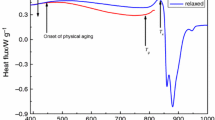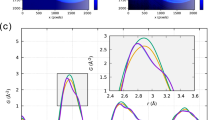Abstract
Structural relaxation behavior of a rapidly quenched (RQ) and a slowly cooled Pd40Cu30Ni10P20 metallic glass was investigated and compared. Differential scanning calorimetry was employed to monitor the relaxation enthalpies at the glass transition temperature, T g , and the Kolrausch–Williams–Watts (KWW) stretched exponential function was used to describe its variation with annealing time. It was found that the rate of enthalpy recovery is higher in the ribbon, implying that the bulk is more resistant to relaxation at low temperatures of annealing. This was attributed to the possibility of cooling rate affecting the locations where the glasses get trapped within the potential energy landscape. The RQ process traps a larger amount of free volume, resulting in higher fragility, and in turn relaxes at the slightest thermal excitation (annealing). The slowly cooled bulk metallic glass (BMG), on the other hand, entraps lower free volume and has more short-range ordering, hence requiring a large amount of perturbation to access lower energy basins.





Similar content being viewed by others
References
I.M. Hodge: J. Non-Cryst. Solids, 1994, vol. 169, pp. 211–66
M.H. Cohen, D. Turnbull: J. Chem. Phys., 1959, vol. 31, pp. 1164–69
O.P. Bobrov, V.A. Khonik, K. Kitagawa, S.N. Laptev: J. Non-Cryst. Solids, 2004, vol. 342, pp. 152–59
C. Nagel, K. Ratzke, E. Schmidtke, J. Wolff, U. Geyer, and F. Faupel: Phys. Rev. B, 1998, vol. 57, pp. 10224–27
A.E. Berlev, O.P. Bobrov, V.A. Khonik, K. Csach, A. Jurikova ,J. Miskuf, H. Neuhauser, M.Y. Yazvitsky: Phys. Rev. B, 2003, vol. 68, pp. 132203–132204
U. Ramamurty, M.L. Lee, J. Basu, Y. Li: Scripta Mater., 2002, vol. 47, pp. 107–11
H.W. Jin, R. Ayer, J.Y. Koo, R. Raghavan, U. Ramamurty: J. Mater. Res., 2007, vol. 22, pp. 264–73
R. Raghavan, P. Murali, U. Ramamurty: Intermetallics, 2006, vol. 14, pp. 1051–54
O.P. Bobrov, K. Csach, S.V. Khonik, K. Kitagawa, S.A. Lyakhov, M. Yu. Yazvitsky, V.A. Khonik: Scripta Mater., 2007, vol. 56, pp. 29–32
N. Nishiyama, A. Inoue: Mater. Trans. JIM, 1997, vol. 38, pp. 464–72
W.H. Jiang, F.X. Liu, Y.D. Wang, H.F. Zhang, H. Choo, P.K. Liaw: Mater. Sci. Eng. A, 2006, vol. 430, pp. 350–54
K.L. Ngai: Non-Debye Relaxation in Condensed Matter, World Scientific, Singapore, 1987
R. Bohmer, K.L. Ngai, C.A. Angell, D.J. Plazek: J. Chem. Phys., 1993, vol. 99, p. 4201
C.A. Angell: J. Non-Cryst. Solids, 1991, vols. 131–133, pp. 13–31
C.A. Angell: J. Phys. Chem. Solids, 1988, vol. 49, p. 863
G.J. Fan, J.F. Loffler, R.K. Wunderlich, H.-J. Fetch: Acta Mater., 2004, vol. 52, pp. 667–74
O.P. Bobrov, K. Csach, V.A. Khonik, S.N. Laptev, and M.Y. Yazvitsky: Scripta Mater., 2006, vol. 54, pp. 369–73
M. Weiss, M. Moske, K. Samwer: Appl. Phys. Lett., 1996, vol. 69, pp. 3200–02
D. Su, R.H. Dauskardt: J. Mater. Res., 2003, vol. 17, pp. 1254–57
P. Murali, U. Ramamurty: Acta Mater., 2005, vol. 53, pp. 1467–78
Acknowledgments
The authors thank Professor S. Ranganathan for his valuable input and Dr. N. Nishiyama for providing the metallic glass samples examined in this study. The authors acknowledge the assistance rendered by Mr. P. Padaikathan in conducting the DSC experiments. This research work was funded by a grant from the Defense Research and Development Organization, Government of India.
Author information
Authors and Affiliations
Corresponding author
Additional information
This article is based on a presentation given in the symposium entitled “Materials Behavior: Far from Equilibrium” as part of the Golden Jubilee Celebration of Bhabha Atomic Research Centre, which occurred December 15–16, 2006 in Mumbai, India.
Rights and permissions
About this article
Cite this article
Raghavan, R., Murali, P. & Ramamurty, U. Influence of Cooling Rate on the Enthalpy Relaxation and Fragility of a Metallic Glass. Metall Mater Trans A 39, 1573–1577 (2008). https://doi.org/10.1007/s11661-007-9262-y
Published:
Issue Date:
DOI: https://doi.org/10.1007/s11661-007-9262-y




